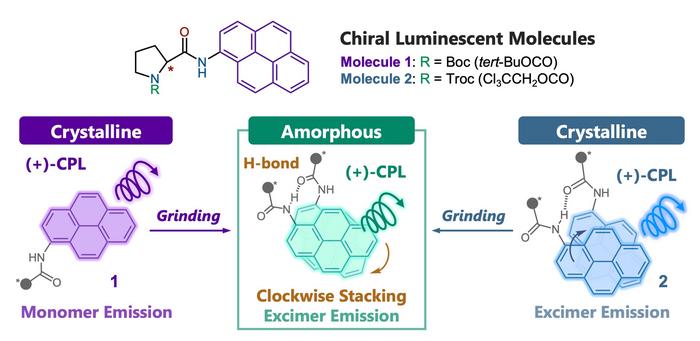
Recent advancements in the field of materials science have introduced intriguing possibilities surrounding mechanoresponsive materials, particularly in regard to circularly polarized luminescence (CPL). CPL phenomena occur when chiral molecules—the types that cannot be superimposed on their mirror images—emit light that rotates in a specific direction when subjected to ultraviolet (UV) irradiation. This distinctive property has garnered significant attention due to its potential applications in cutting-edge technologies such as biosensing, 3D displays, and security printing. A recent study by researchers at Yokohama National University has shone new light on this promising area, investigating how mechanical stimuli can induce transformations in CPL properties, thereby enhancing our understanding of mechanochromic luminescence.
The interplay between mechanical forces and luminescent properties represents a fascinating aspect of modern materials research. Conventional wisdom suggests that exposing luminescent materials to mechanical stress can negatively affect their performance. However, the work conducted by the research team illustrates that not only can mechanical grinding induce various luminescent states within selected molecules, but it can also facilitate the retention of CPL, thereby opening a new frontier in the development of responsive materials. Central to this study are two molecular compounds: chiral pyrenylprolinamides, which differ in luminescence colors due to their unique crystal structures.
The intricate relationship between molecular structure and luminescent behavior highlights the core of mechanochromism—the phenomenon that allows materials to change color in response to mechanical stimulus. The researchers examined how rigid crystalline structures of pyrenylprolinamides respond to grinding, transitioning into amorphous forms while still preserving their circularly polarized properties. This phenomenon defies the traditional expectations set by previous studies, where such transformations typically led to a loss of operational efficiency in CPL emission. The study reveals that, in this instance, the intermolecular hydrogen bonding between stacked pyrene units fosters excimer formation, even when subjected to structural changes typically caused by mechanical disruption.
Notably, one of the most compelling findings from the research involves the alignment of excimers—a type of aggregate formed from excited states of molecules in proximity—within the amorphous material. The research demonstrates that the chirality inherent in these molecules plays a pivotal role in determining the behavior of CPL under mechanical influence. Crucially, while prior research reported a drastic decline in CPL efficiency after mechanical treatment, this study showcases the potential benefits of specific molecular engineering strategies that can enhance the robustness of CPL in the face of stress.
Furthermore, the structural characteristics afforded by the different derivatives of the pyrenylprolinamides provide insights into optimizing future designs for solid-state CPL materials. The first compound, a tert-butoxycarbonyl (Boc) derivative, and the second, a trichloroethoxycarbonyl (Troc) derivative, each contribute unique traits to the overall luminescent interaction. Through synthesis and manipulation of these compounds, the researchers are paving the way for innovative applications that harness the benefits of mechanical stimuli to influence luminescent properties.
In the broader context of materials science, findings such as these represent a leap forward in our understanding of how light-emitting materials can be engineered to interact intelligently with their environment. The implications of developing solid-state materials capable of reversible CPL switching through the application of mechanical forces are vast. Potential applications range from more advanced 3D display technologies that produce vivid colors and depth perception to enhanced security printing that employs unique luminescent features that can change under duress.
As the research progresses, the team, led by Suguru Ito of Yokohama National University, plans to establish comprehensive design guidelines for future studies. Such guidelines aim to streamline the process of developing responsive materials that can be efficiently integrated into a variety of technological frameworks. With ambitions to achieve widespread implementation of solid-state CPL materials, this research front promises to revolutionize existing technologies and foster innovations yet unseen.
Importantly, the interplay of mechanical force and luminescent function beckons a deeper investigation into new avenues for application. Machine learning and computational modeling could be leveraged to create predictive tools that enhance the design process for new materials. By utilizing these advanced technologies alongside empirical research, future studies can minimize the lead time required to convert laboratory findings into market-ready products. This synergistic approach would not only benefit academic spheres but also expedite commercial interest in next-generation materials.
The study’s findings, published in Angewandte Chemie International Edition, represent a significant milestone in the ongoing exploration of mechanoresponsive materials. With the encouragement of institutions such as JST PRESTO and JSPS KAKENHI, the research received a platform to share its insights with the scientific community, fostering collaboration and innovation among researchers across disciplines. The momentum generated by this research has positioned Yokohama National University at the forefront of materials science, where interdisciplinary studies continue to yield transformative discoveries.
With additional collaborators from various prestigious institutions contributing to this research, the implications of these findings extend beyond individual applications; they hold the potential to reshape a significant portion of the technological landscape as we understand it today. By continuing to harness the principles of chirality and inter-molecular interactions, researchers can dive deeper into the mechanics of light and its relationship with material properties.
In summary, the ongoing research exploring the mechanics behind CPL phenomena amidst structural changes presents a groundbreaking perspective on how materials can be designed for stress-responsive functionalities. As scientists delve deeper into these exciting areas, the fusion of mechanics and photonics offers a glimpse of the future—one where our materials can not only respond to stimuli but can also adapt to a variety of applications seamlessly.
Subject of Research: Mechanical stimuli-induced transformations in circularly polarized luminescence properties of chiral small organic molecules.
Article Title: Contrasting Mechanochromic Luminescence of Enantiopure and Racemic Pyrenylprolinamides: Elucidating Solid-State Excimer Orientation by Circularly Polarized Luminescence.
News Publication Date: January 22, 2025.
Web References: Angewandte Chemie International Edition
References: DOI: 10.1002/anie.202422913
Image Credits: Credit: Yokohama National University
Keywords
Circularly Polarized Luminescence, Mechanochromic Luminescence, Chiral Molecules, Solid-State Chemistry, Excimer Emission.
Tags: 3D display advancementsadvanced security printing technologiesbiosensing innovationschiral molecules and light emissioncircularly polarized luminescence applicationscolor-changing molecular structuresmaterials science breakthroughsmechanical stimuli effects on luminescencemechanochromic luminescence researchmechanoresponsive materialspyrenylprolinamides propertiesresponsive materials development





